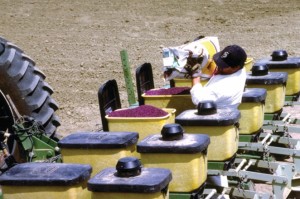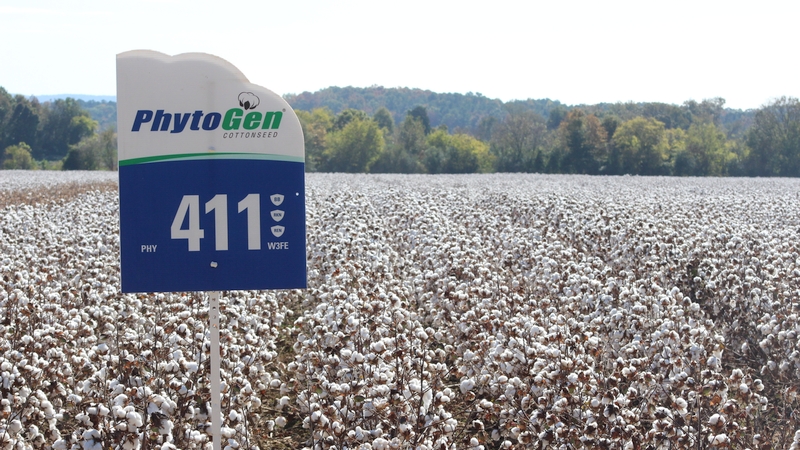Seeding Rates: A Numbers Game

As a vocal proponent of nearly all-things precision agriculture, Cotton Incorporated was highly interested in Arkansas Extension specialist Tom Barber’s findings on the subject of seeding rates. Cotton Incorporated Director of Agriculture Research, Dr. Ed Barnes, says variable rate planting is something that most growers will be apprehensive about initially.
“When it comes to seed-control, the investment is more involved with a planter. So that is a practice where people are asking whether it is going to pay off,” Barnes says.
That is a question Cotton Incorporated was asking from the outset, as well. In providing support to Barber’s research, they intended to find an answer.
The study set out to learn how to match seeding rates with soil types for optimum profitability. To accomplish this, Barber and his fellow researchers set up the trials on multiple working farms across the Mid-South. The trials featured replicated strips of 12 rows, with three or four replications apiece, depending on the location.
Each location was mapped with Veris data so researchers were equipped with the knowledge of each test sight’s soil electrical conductivity (EC) value as it related to the soil types. Some locations, like one particular field in Mississippi County, AR, featured high variability in soil types across the field.
“We planted these strips at a solid rate all the way across the field,” Barber says. “There were five test strips, and the lowest one was planted around 28,000 seed per acre, while the highest one was around 70,000 seed per acre.
The researchers then looked at a yield map and reviewed the yield data, extracting the yield numbers for those strips spatially. Barber and his fellow researchers utilized an algorithm to determine the most profitable yield-above-seeding cost for each soil type, while accounting for outside variables such as seed cost.
“In fields with high variability, like that Mississippi County field that went from sand-blown soil all the way to heavy clay, from end to end, we got a good idea of what we were looking at,” Barber says. “For that lighter soil, the sandier soil, the lower seeding rate was better. Between 30,000 and 33,000 seed per acre was our optimal seeding rate on sandier soil.”
As the soil got denser, Barber detected a pattern forming in the optimal seeding rates.
“When we got up to the more silt-loam type soils, we pulled in a range from seven to 18 or so EC, we saw that 40,000 to 43,000 seed per acre was optimal, generally. So in that case, again we’re talking return-over-seed costs. And then for the heavy ground, which has an EC above 20, we found that 50,000 to 55,000 seed per acre was the most optimum rate,” Barber summarized.
Barber says the data collected from the field in Mississippi County backed up the majority of the findings from the rest of the study. Whether in Marianna or Kaiser, fields all across Arkansas bore the same results; more seed per acre was better on heavier soils, while less seed per acre was more optimal on lighter soils.
Barber ran the math to demonstrate how this information was valuable to a cotton producer’s bottom line.
“In that Mississippi County field, our average recommended seeding rate had been around 48,000 seed per acre,” Barber explains. “Well, by planting less seed in the sand and more seed in the clay, at the end of the day, we saved him on average 8,000 seed per acre. At current seed prices, that’s a savings of about $20 an acre.”
Of course, soil type isn’t the only determining factor in seeding rate. As Barber points out, there are some areas in a field that simply won’t produce, no matter what the seeding rate may be. Speaking of areas like dryland corners in circle-pivot fields, Barber says even more savings can occur if variable-rate seeding practices are used.
“If it’s a lower producing area – like an area outside a pivot, we cut back our seeding rate to 2 to 2.5 seed per foot in some cases in the study,” Barber says. “If it’s in a sand-blow that very rarely produces anything, then we cut the seeding rate back to about 1.5 seed per foot.
“We’ll still drop some seed in case it does rain all the time and the cotton lives, but nine years out of 10, those sand-blows aren’t going to produce a whole lot.”
Doing Your Homework
Barber stresses that growers who want to employ this variable-rate seeding system will need to do their own background work to make the system work on their particular farm, with their particular circumstances. There was enough variability in the results of his study to make him wary of a grower applying his precise findings and recommendations across thousands of acres, sight unseen.
“We had a grower say, ‘Well, I’m going to apply this over my whole farm, just like you said,’” Barber says. “That makes me a little nervous when you’re talking about doing this across 10,000 or 12,000 acres of cotton all at once. It’s hard to make the models that we did for this 350 acres fit on a broad brush like that.
“Everybody has to take into account their scenarios and their experiences in order to build the map.”
In addition to employing Veris mapping and yield monitors, growers who practice variable rate seeding will also need to equip their planters with seeding technology. Barber says that advances in hydraulics-based planting software have increased the efficiency of this practice.
“Just like any other variable rate application, you put your prescription for seeding into a John Deere controller, for example, and then it tells the planter whether to speed up or slowdown the seed drop,” says Barber, referencing John Deere’s GreenStar Variable Rate Application technology.
While variable rate applications used to be driven by the speed of the wheels turning as a tractor moved through the field, hydraulically controlled systems operate based on what that controller tells them to do. Barber points out that there are also some after-market electric drives that work off an electric system to produce variable rate seeding.
“You have to rig your planter for those. You also have to have a seed-monitoring system in the planter that helps calibrate itself. So basically it has little eyes that count the seeds as they go down, and it adjusts itself based on whether or not it’s putting out the right amount,” Barber says.
Barnes and other precision ag proponents say building blocks like soil mapping and variable-rate technology can be useful in many other practices, in addition to helping growers save money through variable rate seeding.









